 Technology peripherals
Technology peripherals
 AI
AI
 The industry's first neural network wave function suitable for solid systems was published in the Nature sub-journal
The industry's first neural network wave function suitable for solid systems was published in the Nature sub-journal
The industry's first neural network wave function suitable for solid systems was published in the Nature sub-journal
Machine learning can process massive amounts of data, solve scientific problems in complex scenarios, and lead scientific exploration to new areas that were previously unreachable. For example, DeepMind uses the artificial intelligence software AlphaFold to make highly accurate predictions of almost all protein structures known to the scientific community; the particle image velocimetry (PIV) method based on deep learning proposed by Christian Lagemann has greatly improved the original purely manual setting of parameters. The application scope of the model is of vital significance to research in many fields such as automobiles, aerospace, and biomedical engineering.
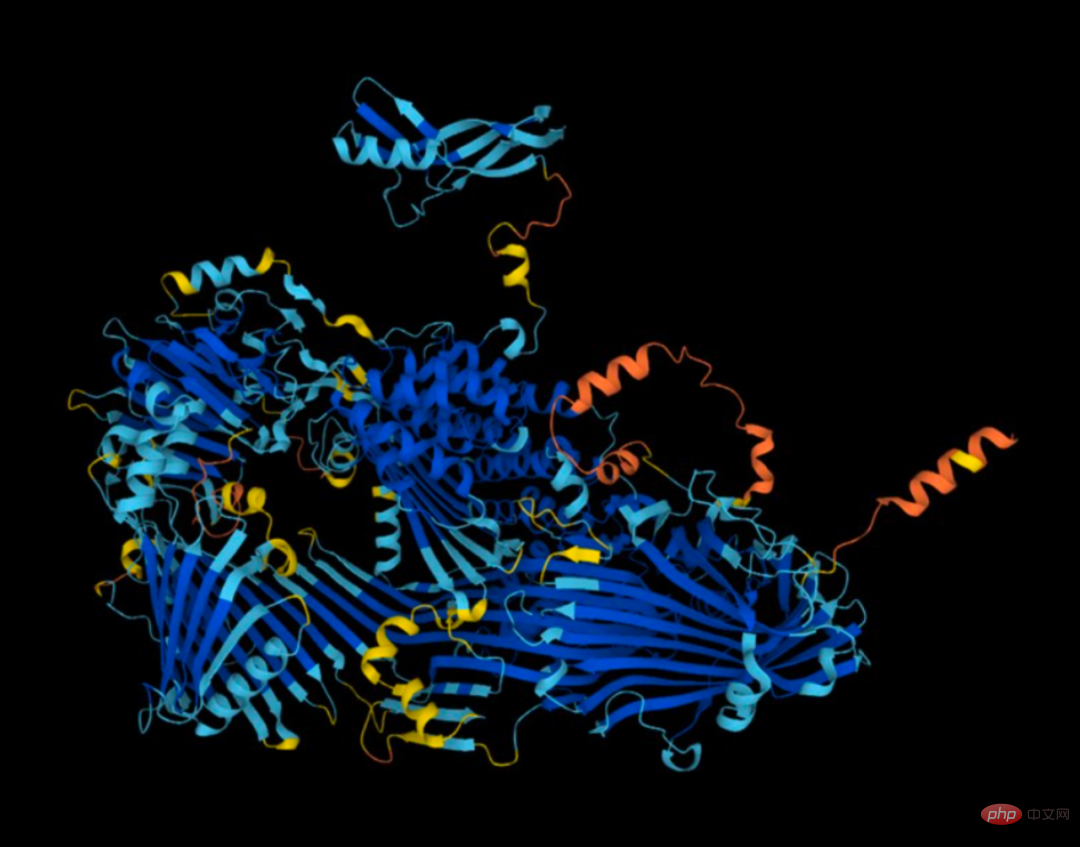
AlphaFold can predict the structure of almost all known proteins (Source: DeepMind)
With sufficient data and an accurate model to describe the scientific problems to be solved, many "hundred-year-old mysteries" in basic science can be solved by machine learning. Such as fluid mechanics, condensed matter physics, organic chemistry, etc.
Recently, the work "Ab initio calculation of real solids via neural network ansatz" by the ByteDance AI Lab Research team and Chen Ji's research group at the School of Physics at Peking University provides a way to study condensed matter. A new idea in physics, this work proposes the industry's first neural network wave function suitable for solid systems, realizes first-principles calculations of solids, and pushes the calculation results to the thermodynamic limit. It strongly proves that neural networks are efficient tools for studying solid-state physics, and also indicates that deep learning technology will play an increasingly important role in condensed matter physics. Relevant research results were published in the top international journal Nature Communication on December 22, 2022.
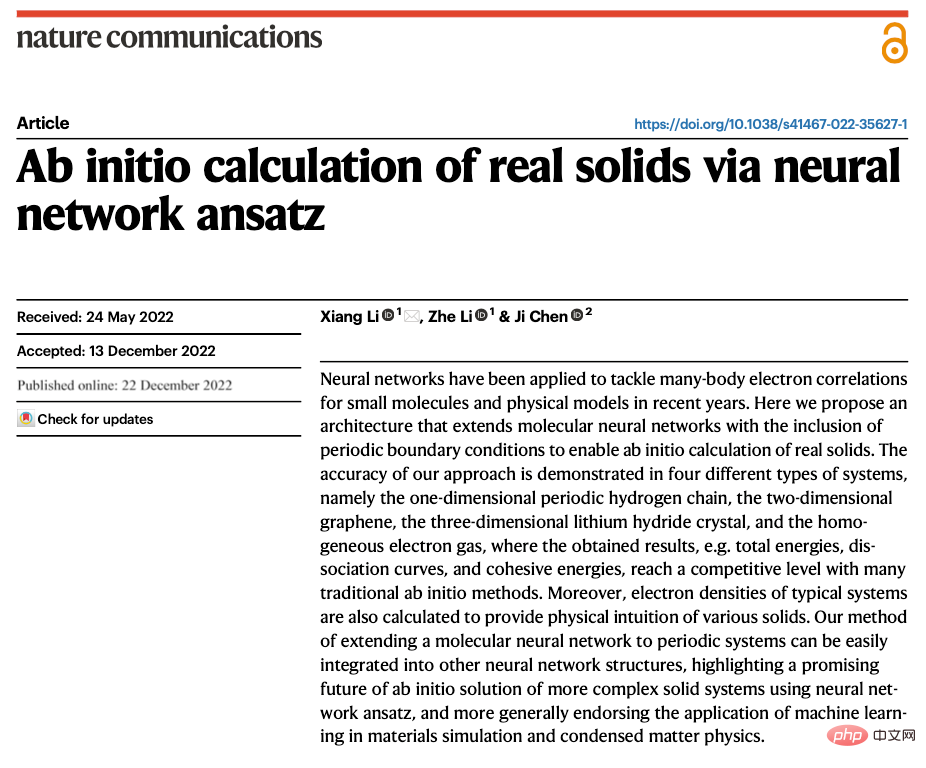
Paper link: https://www.nature.com/articles/s41467-022-35627-1
Research background and research methods
Accurately solving the Schrödinger equation of solid systems is one of the holy grails of condensed matter physics. In condensed matter research over the past few decades, density functional theory has been widely adopted with great success.
Density functional theory: A quantum mechanical method for studying the electronic structure of multi-electron systems.
Despite this, density functional theory still has many shortcomings: for complex strongly correlated systems, density functional theory cannot provide to produce an accurate description; there is also a lack of systematic methods to improve its accuracy in functional selection. In recent years, compared with density functional theory, the more accurate and universal wave function method has received more and more attention and research.
In view of this situation, the ByteDance AI Lab Research team teamed up with Chen Ji’s research group at the School of Physics of Peking University to design a periodic neural network wave function suitable for solid systems, and combined it with quantum The combination of Monte Carlo methods enables first-principles calculations of solid systems. In this work, deep learning technology was applied to the study of solid systems in continuous space for the first time and pushed the calculation to the thermodynamic limit.
The core of this work is to combine the periodic generalized system eigenvector with the existing molecular neural network wave function to construct a solid with periodic symmetry and complete antisymmetry System wave function. The work then applied quantum Monte Carlo methods to efficiently train neural networks and tested them on a range of real solids.
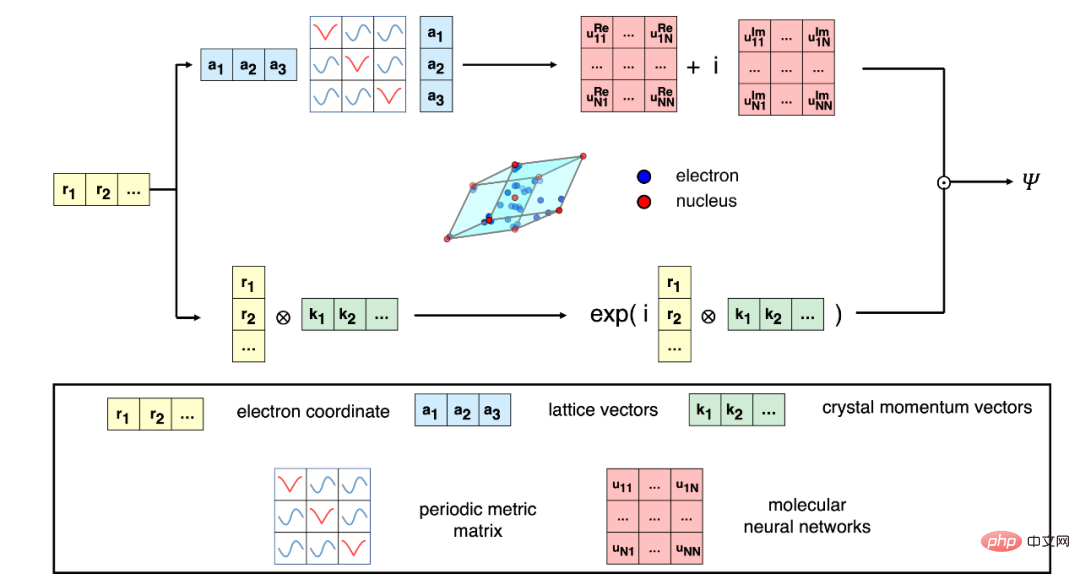
Experimental results and analysis
#First of all, the author periodically Tests were conducted on one-dimensional hydrogen chains. The one-dimensional hydrogen chain is one of the most classic systems in condensed matter, and its accurate solution helps people understand the characteristics of strongly correlated systems. Calculation results show that the neural network can achieve accuracy similar to traditional high-precision methods (such as auxiliary field Monte Carlo).
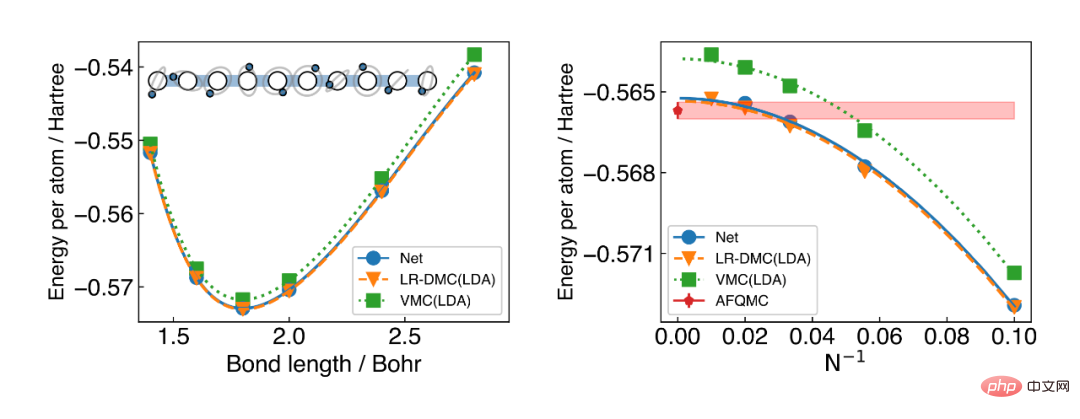
The author then used a neural network to calculate the two-dimensional graphene material. Graphene has been a hot research material in the past two decades. Its unique properties in thermal conductivity, electrical conductivity, etc. have important research and application value. This work accurately calculated the cohesive energy of graphene, and the calculation results were consistent with the experimental data.
#In order to further verify the effectiveness of the work, the author calculated the three-dimensional lithiated hydrogen material and pushed the calculation scale to the thermodynamic limit. The maximum calculation scale reached With 108 electrons, this is also the largest solid system that a neural network can simulate so far. The calculated cohesive energy and bulk modulus of the material are consistent with the experimental results.
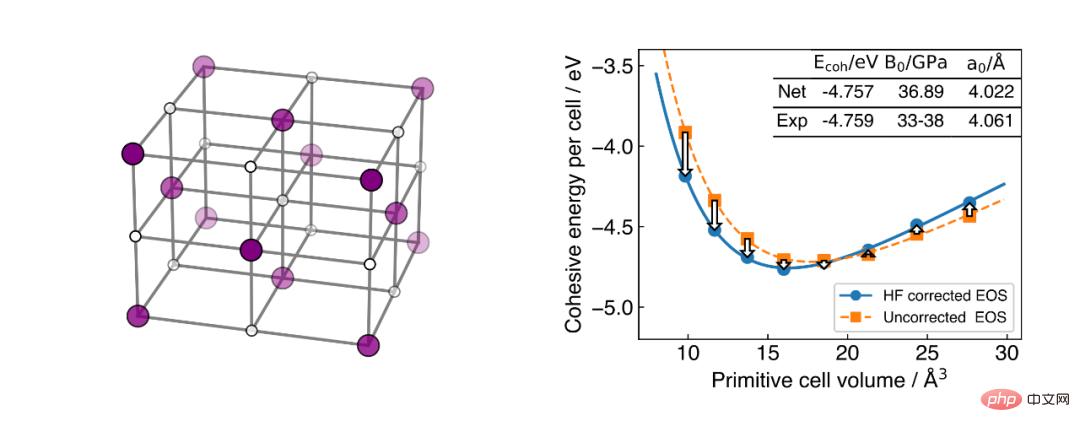
Finally, the author studied the theoretically more interesting uniform electron gas system. The uniform electron gas system is closely related to many novel physical effects (such as the quantum Hall effect), so an in-depth understanding of the uniform electron gas has important theoretical value. The calculation results show that the neural network achieves good results on uniform electron gas, approaching or even surpassing the results of many traditional high-precision methods.

This work strongly proves that neural networks are efficient tools for studying solid state physics. With the further improvement of the algorithm, neural network technology will play a more important role in condensed matter physics: such as phase changes of solid systems, surface physics, unconventional superconductors, etc. Research on these topics requires high-precision solid wave functions as the cornerstone. At the same time, the author is also working on researching more efficient neural network wave functions to provide more possibilities for the study of condensed matter physics.
The above is the detailed content of The industry's first neural network wave function suitable for solid systems was published in the Nature sub-journal. For more information, please follow other related articles on the PHP Chinese website!

Hot AI Tools

Undresser.AI Undress
AI-powered app for creating realistic nude photos

AI Clothes Remover
Online AI tool for removing clothes from photos.

Undress AI Tool
Undress images for free

Clothoff.io
AI clothes remover

AI Hentai Generator
Generate AI Hentai for free.

Hot Article

Hot Tools

Notepad++7.3.1
Easy-to-use and free code editor

SublimeText3 Chinese version
Chinese version, very easy to use

Zend Studio 13.0.1
Powerful PHP integrated development environment

Dreamweaver CS6
Visual web development tools

SublimeText3 Mac version
God-level code editing software (SublimeText3)

Hot Topics
 Bytedance Cutting launches SVIP super membership: 499 yuan for continuous annual subscription, providing a variety of AI functions
Jun 28, 2024 am 03:51 AM
Bytedance Cutting launches SVIP super membership: 499 yuan for continuous annual subscription, providing a variety of AI functions
Jun 28, 2024 am 03:51 AM
This site reported on June 27 that Jianying is a video editing software developed by FaceMeng Technology, a subsidiary of ByteDance. It relies on the Douyin platform and basically produces short video content for users of the platform. It is compatible with iOS, Android, and Windows. , MacOS and other operating systems. Jianying officially announced the upgrade of its membership system and launched a new SVIP, which includes a variety of AI black technologies, such as intelligent translation, intelligent highlighting, intelligent packaging, digital human synthesis, etc. In terms of price, the monthly fee for clipping SVIP is 79 yuan, the annual fee is 599 yuan (note on this site: equivalent to 49.9 yuan per month), the continuous monthly subscription is 59 yuan per month, and the continuous annual subscription is 499 yuan per year (equivalent to 41.6 yuan per month) . In addition, the cut official also stated that in order to improve the user experience, those who have subscribed to the original VIP
 Context-augmented AI coding assistant using Rag and Sem-Rag
Jun 10, 2024 am 11:08 AM
Context-augmented AI coding assistant using Rag and Sem-Rag
Jun 10, 2024 am 11:08 AM
Improve developer productivity, efficiency, and accuracy by incorporating retrieval-enhanced generation and semantic memory into AI coding assistants. Translated from EnhancingAICodingAssistantswithContextUsingRAGandSEM-RAG, author JanakiramMSV. While basic AI programming assistants are naturally helpful, they often fail to provide the most relevant and correct code suggestions because they rely on a general understanding of the software language and the most common patterns of writing software. The code generated by these coding assistants is suitable for solving the problems they are responsible for solving, but often does not conform to the coding standards, conventions and styles of the individual teams. This often results in suggestions that need to be modified or refined in order for the code to be accepted into the application
 Seven Cool GenAI & LLM Technical Interview Questions
Jun 07, 2024 am 10:06 AM
Seven Cool GenAI & LLM Technical Interview Questions
Jun 07, 2024 am 10:06 AM
To learn more about AIGC, please visit: 51CTOAI.x Community https://www.51cto.com/aigc/Translator|Jingyan Reviewer|Chonglou is different from the traditional question bank that can be seen everywhere on the Internet. These questions It requires thinking outside the box. Large Language Models (LLMs) are increasingly important in the fields of data science, generative artificial intelligence (GenAI), and artificial intelligence. These complex algorithms enhance human skills and drive efficiency and innovation in many industries, becoming the key for companies to remain competitive. LLM has a wide range of applications. It can be used in fields such as natural language processing, text generation, speech recognition and recommendation systems. By learning from large amounts of data, LLM is able to generate text
 Can fine-tuning really allow LLM to learn new things: introducing new knowledge may make the model produce more hallucinations
Jun 11, 2024 pm 03:57 PM
Can fine-tuning really allow LLM to learn new things: introducing new knowledge may make the model produce more hallucinations
Jun 11, 2024 pm 03:57 PM
Large Language Models (LLMs) are trained on huge text databases, where they acquire large amounts of real-world knowledge. This knowledge is embedded into their parameters and can then be used when needed. The knowledge of these models is "reified" at the end of training. At the end of pre-training, the model actually stops learning. Align or fine-tune the model to learn how to leverage this knowledge and respond more naturally to user questions. But sometimes model knowledge is not enough, and although the model can access external content through RAG, it is considered beneficial to adapt the model to new domains through fine-tuning. This fine-tuning is performed using input from human annotators or other LLM creations, where the model encounters additional real-world knowledge and integrates it
 To provide a new scientific and complex question answering benchmark and evaluation system for large models, UNSW, Argonne, University of Chicago and other institutions jointly launched the SciQAG framework
Jul 25, 2024 am 06:42 AM
To provide a new scientific and complex question answering benchmark and evaluation system for large models, UNSW, Argonne, University of Chicago and other institutions jointly launched the SciQAG framework
Jul 25, 2024 am 06:42 AM
Editor |ScienceAI Question Answering (QA) data set plays a vital role in promoting natural language processing (NLP) research. High-quality QA data sets can not only be used to fine-tune models, but also effectively evaluate the capabilities of large language models (LLM), especially the ability to understand and reason about scientific knowledge. Although there are currently many scientific QA data sets covering medicine, chemistry, biology and other fields, these data sets still have some shortcomings. First, the data form is relatively simple, most of which are multiple-choice questions. They are easy to evaluate, but limit the model's answer selection range and cannot fully test the model's ability to answer scientific questions. In contrast, open-ended Q&A
 SOTA performance, Xiamen multi-modal protein-ligand affinity prediction AI method, combines molecular surface information for the first time
Jul 17, 2024 pm 06:37 PM
SOTA performance, Xiamen multi-modal protein-ligand affinity prediction AI method, combines molecular surface information for the first time
Jul 17, 2024 pm 06:37 PM
Editor | KX In the field of drug research and development, accurately and effectively predicting the binding affinity of proteins and ligands is crucial for drug screening and optimization. However, current studies do not take into account the important role of molecular surface information in protein-ligand interactions. Based on this, researchers from Xiamen University proposed a novel multi-modal feature extraction (MFE) framework, which for the first time combines information on protein surface, 3D structure and sequence, and uses a cross-attention mechanism to compare different modalities. feature alignment. Experimental results demonstrate that this method achieves state-of-the-art performance in predicting protein-ligand binding affinities. Furthermore, ablation studies demonstrate the effectiveness and necessity of protein surface information and multimodal feature alignment within this framework. Related research begins with "S
 Five schools of machine learning you don't know about
Jun 05, 2024 pm 08:51 PM
Five schools of machine learning you don't know about
Jun 05, 2024 pm 08:51 PM
Machine learning is an important branch of artificial intelligence that gives computers the ability to learn from data and improve their capabilities without being explicitly programmed. Machine learning has a wide range of applications in various fields, from image recognition and natural language processing to recommendation systems and fraud detection, and it is changing the way we live. There are many different methods and theories in the field of machine learning, among which the five most influential methods are called the "Five Schools of Machine Learning". The five major schools are the symbolic school, the connectionist school, the evolutionary school, the Bayesian school and the analogy school. 1. Symbolism, also known as symbolism, emphasizes the use of symbols for logical reasoning and expression of knowledge. This school of thought believes that learning is a process of reverse deduction, through existing
 SK Hynix will display new AI-related products on August 6: 12-layer HBM3E, 321-high NAND, etc.
Aug 01, 2024 pm 09:40 PM
SK Hynix will display new AI-related products on August 6: 12-layer HBM3E, 321-high NAND, etc.
Aug 01, 2024 pm 09:40 PM
According to news from this site on August 1, SK Hynix released a blog post today (August 1), announcing that it will attend the Global Semiconductor Memory Summit FMS2024 to be held in Santa Clara, California, USA from August 6 to 8, showcasing many new technologies. generation product. Introduction to the Future Memory and Storage Summit (FutureMemoryandStorage), formerly the Flash Memory Summit (FlashMemorySummit) mainly for NAND suppliers, in the context of increasing attention to artificial intelligence technology, this year was renamed the Future Memory and Storage Summit (FutureMemoryandStorage) to invite DRAM and storage vendors and many more players. New product SK hynix launched last year





